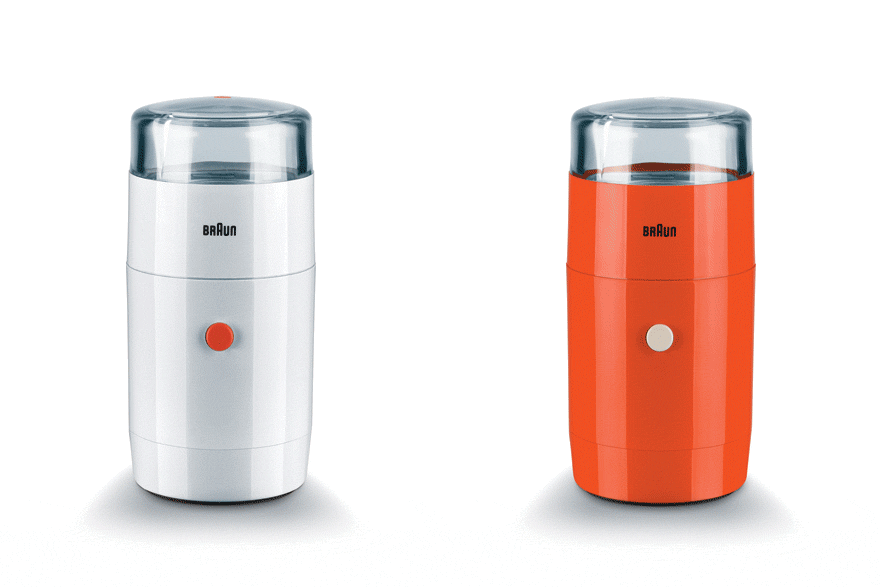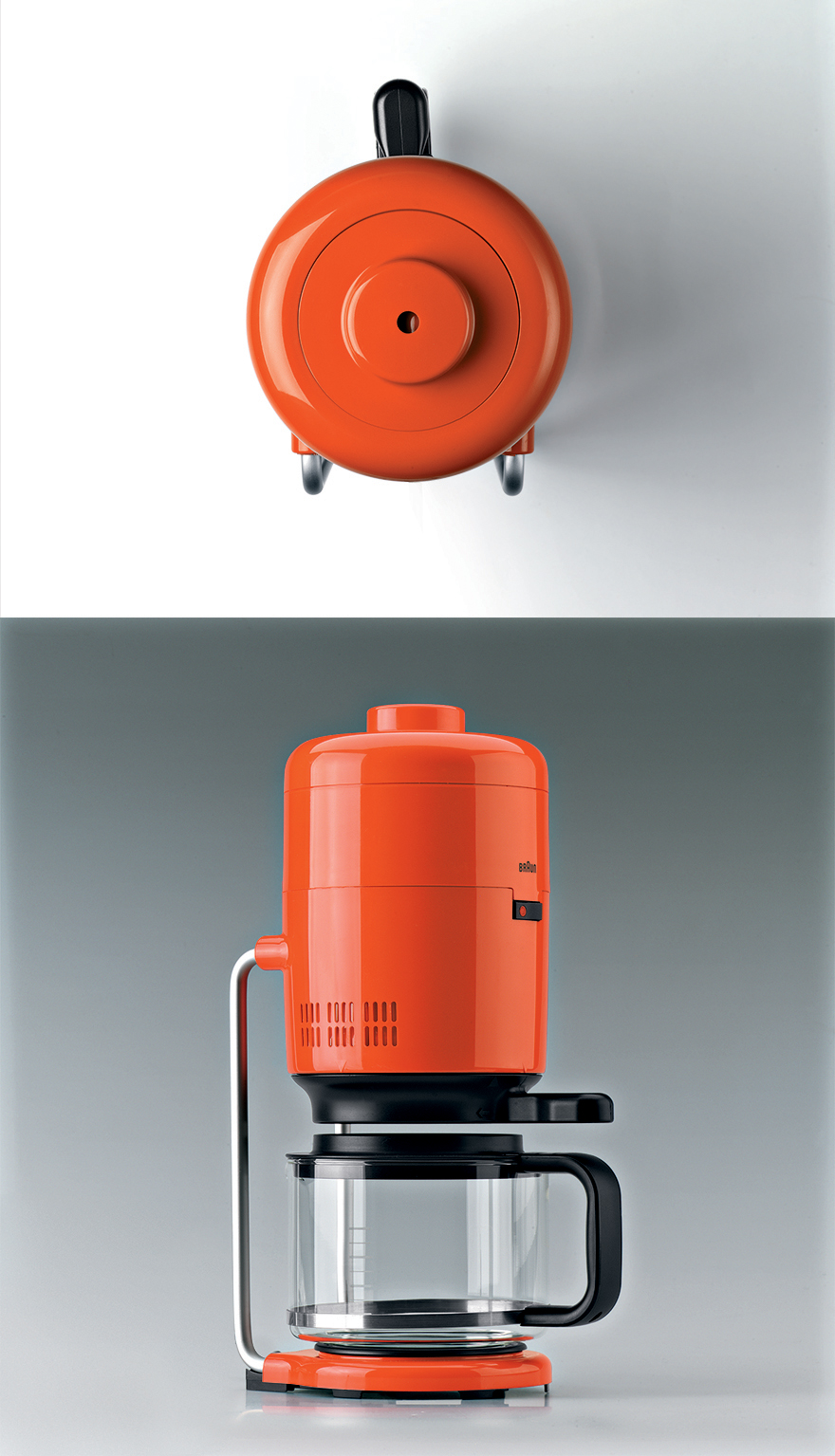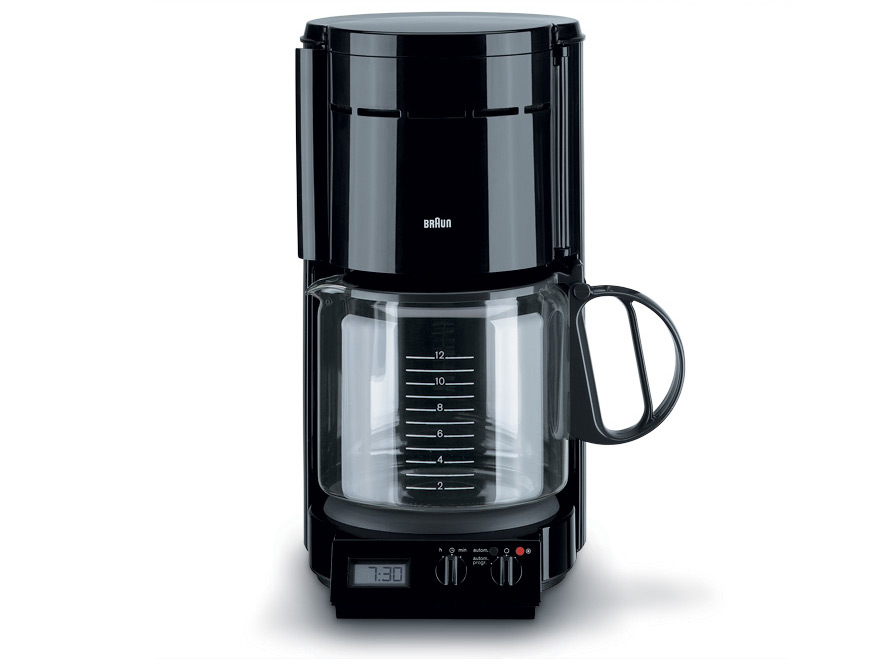A History of Braun Design, Part 4: Kitchen Appliances

As we've seen in earlier installments of this series, Braun revolutionized the product categories of audio entertainment, personal grooming and even time-telling. By the 1950s, they begun to expand out of the living room, the bathroom and the bedroom to transform the most crucial of household spaces: The kitchen, where every family's sustenance was prepared. It was arguably the space where the housewives of the era, and the children they minded, spent the most time.
It was also a room for work, where design had yet to make a significant impact in easing the burden of labor. Braun's designers tackled kitchen tasks with their characteristically superb analysis of what was needed, and how those objects should look and function. They began by introducing a host of diverse kitchen products, but it was the preparation of one hot beverage in particular—coffee—which allowed them to knock it out of the park time and again, in their relentless search of design perfection.

1957 KM 3 Gerd Alfred Muller
From the get-go, it became clear that Braun would forge their own design path in this category. The KM 3 food processor was radically different from then-dominant American mixers of the time, which followed that country's streamlined, chrome-heavy style and often look as if they were manufactured by Chevy. The sleek, simple KM 3, in contrast, looked as if it were related to Braun's electric razors of the era. But this was no example of trying to graft the design of one product category onto another; the smooth, largely featureless shape was easy to clean. Attesting to the successful design of the KM 3 is that it would see production, with slight modifications, for more than thirty years.

1961 HE 1/12 Reinhold Weiss
The elegantly curved, white design language of the KM 3 was not to be blandly applied to the entire category. The serious, chrome-and-black look of the HE 1/12 electric kettle warns the user that this is a device like a cooking pot--it gets hot and ought to be treated with respect.

1962 MX 32 Gerd Alfred Muller, Robert Oberheim
The MX 32 blender was allowed to borrow the design language of the KM 3 because it made sense; the device ought be easy to clean. Chrome was permitted here for the security of the metal connection point between the pitcher and the base. And as with the KM 3, rubber feet would help dampen the vibration of the spinning motor.

1962 HG 1 Reinhold Weiss
If the KM 3 and the MX 32 carried the design DNA of Braun's electric razors, the HG 1 countertop grill was related to Braun stereos of the era: It was hard-edged and no-nonsense. Again we see the black-and-chrome material scheme warning of high heat, with the controls that the user could safely touch set off from the metal surface. And unusually, it had not only a glass front, but also a glass rear, providing a more even illumination for the user checking on the contents.

1963 HT 2 Reinhold Weiss
Something like a sleeker, more compact version of the HG 1 grill, the HT 2 toaster carried the same hard-edged design language as Braun's audio products. The controls are set off to the side, and as with the HE 1/12 and the HG 1, the color and materials scheme speak loudly and clearly: This device gets hot, and you can safely touch the black parts, but don't touch the shiny chrome.
1965 KMM 1/121 Reinhold Weiss
Braun now meant to do away with the hand-powered coffee grinders found in kitchens of the time by applying technology. The motorized KMM 1/121 reportedly used a mechanism physically similar to what you'd find in a stone mill, and the formal language of the device represents what it does: The relatively soft shape of the cylinder is where the beans go, and after being processed, they fall into the angular-shaped hopper.

1967 KSM 1/11 Reinhold Weiss Coffee grinder
The KSM 1/11, in contrast to its more complicated predecessor, was smaller, sleeker and minimalist. An internal hammer mechanism helped crush the beans, which went into, and came out of, the same chamber capped by the removable transparent top. The form of the object is such that even someone with no coffee-grinding experience would find it impossible to mis-use.

1969 KMM 2 Dieter Rams
Braun did not abandon the stone-mill grinding system of the KMM series in favor of the 1972
KF 20
Florian Seiffert By now the form factor of the modern drip-filter coffeemaker is so embedded in our minds that it is difficult to see how revolutionary the KF 20 was. Up until the 1970s people had been brewing, steeping, percolating, even siphoning coffee using whatever assortment of gadgets their parents had. Here Seiffert had reconciled the technological/mechanical requirements of creating coffee--heating the water, steeping it, filtering finished product into a vessel, keeping that vessel heated--into a tidy and sleek cylindrical shape. The process was rendered largely invisible, with the workings hidden within the body and the elegant metal pipe supporting the "water tower" containing the wiring for the upper and lower heating elements. 1972
KF 21
Florian Seiffert, Hartwig Kahlcke As we now know, Braun is not an organization to rest on their laurels, and the same year as the KF 20 came out, so too did a slight redesign. Kahlcke's re-designed pot featured a handle design that made it impossible to accidentally brush your knuckles on the hot glass of the pot. 1975
KMM 10
Reinhold Weiss, Hartwig Kahlcke People were now drinking more coffee—perhaps fueled by sales of the KF 20 and KF 21—and this update to the KMM 1/121 coffee grinder featured a larger-capacity feed hopper. Technology, too, was added in the form of a timer, freeing the user from needing to stand by as the grinder did its work. 1977
KF 30
Hartwig Kahlcke Having nailed the coffeemaker form factor with the KF 20, Braun's designers set about trying to improve it. The KF 30 moved the bulky upper heating element of its predecessors and now relied on the lower heating element to do double-duty: It would both keep the pot warm and heat the water, which would then be piped back up top to drip down through the filter. 1978
KF 35
Hartwig Kahlcke Just a year after the KF 30 came the KF 35, which was largely identical, but once again featured a redesigned pot by Kahlcke and a slight bulge in the tower portion, presumably the result of some inner technology-wrangling. (Seen from the side, the earlier KF 30's tower is a perfect cylinder.) 1979
KSM 2
Hartwig Kahlcke Looking at the earlier KSM 1 coffee grinder, it seems impossible to modify its perfect shape. But Kahlcke found a way. Here the button has been changed to a plunger-type connected to the removable transparent lid, further simplifying the operation. The channel circumnavigating the base is for the user to wrap the cord around, keeping things tidy. 1984
KF 40
Hartwig Kahlcke The KF 40 moves back towards what the original KF 20 was trying to accomplish: A monolithic form factor. Having "learned" from the KF 30, with its singular heating element design, the KF 40 harkens back to a singularity of form not seen since the HE 1/12 electric kettle. (Author's note: The coffee maker I still use today, on a daily basis, is a KF 40 purchased in the '90s.) 1986
KF 70
Hartwig Kahlcke The only way to make the KF 40 any sleeker, any more monolithic-looking, would be to get rid of the glass material for the pot. This Braun did with the KF 70, but not for aesthetic reasons: Here the pot has been supplanted by an insulated thermos, for coffee-on-the-go. 1986
KF 80
Hartwig Kahlcke The KF 80 was the KF 40 on technological steroids: It featured a digital clock connected to a timer, allowing users on a schedule to have fresh coffee waiting for them at a predetermined time. 1994
KF 12
Ludwig Littmann As single consumers, as opposed to entire families, became a purchasing force, the smaller-capacity KF 12 became an attractive option for those who didn't need to brew more than a few cups at a time. Placed side-by-side with the KF 40, it resmembles that machine's little brother.









-
o3Favorite This
-
Q6Comment
K
{Welcome
Create a Core77 Account
Already have an account? Sign In
By creating a Core77 account you confirm that you accept the Terms of Use
K
Reset Password
Please enter your email and we will send an email to reset your password.


Comments
I am the proud owner of a Braun KM3 food mixer. My mother bought it before I was born in 1964 and it is still in regular use. I've not found anything better. Looking at the various coffee mill designs none of them would look dated in a domestic appliance showroom today.
The sleek all white carafe for the KF70 & KF80 12 cup coffee maker although it looks like an insulated thermos jug, is actually also a glass carafe with an all plastic outer housing. The bottom is clear glass. An insulated thermos jug would have been a great alternative to the standard glass carafe. I am still searching for the sane sleek all white carafe for the KF172 (1995) & a later metallic green version KF178 (2001). I prefer & collect the all white versions but I am curious if these also were available in black.
Can you, by any chance, tell me when Braun first introduced their immersion blender to the US market?
If you mean the Braun MR 6 designed by Ludwig Littman, it was from 1981.
Love Braun and these designs are wonderful, BUT the KM 32 Kitchen Machine has a fault!